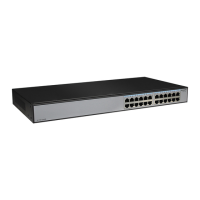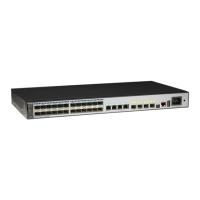SwitchB XGigabitEthernet0/0/1 VLANIF 10 10.1.1.1/24
SwitchB XGigabitEthernet0/0/2 VLANIF 20 10.1.2.1/24
SwitchB XGigabitEthernet0/0/3 VLANIF 40 10.1.4.1/24
SwitchB XGigabitEthernet0/0/4 VLANIF 50 10.1.5.1/24
SwitchC XGigabitEthernet0/0/1 VLANIF 30 10.1.3.1/24
SwitchC XGigabitEthernet0/0/2 VLANIF 20 10.1.2.2/24
SwitchC XGigabitEthernet0/0/3 VLANIF 70 10.1.7.1/24
SwitchC XGigabitEthernet0/0/4 VLANIF 80 10.1.8.1/24
SwitchC XGigabitEthernet0/0/5 VLANIF 90 10.1.9.1/24
SwitchD XGigabitEthernet0/0/1 VLANIF 40 10.1.4.2/24
SwitchD XGigabitEthernet0/0/2 VLANIF 60 10.1.6.1/24
SwitchE XGigabitEthernet0/0/1 VLANIF 50 10.1.5.2/24
SwitchE XGigabitEthernet0/0/2 VLANIF 60 10.1.6.2/24
SwitchF XGigabitEthernet0/0/1 VLANIF 70 10.1.7.2/24
SwitchG XGigabitEthernet0/0/1 VLANIF 80 10.1.8.2/24
SwitchH XGigabitEthernet0/0/1 VLANIF 90 10.1.9.2/24
Configuration Roadmap
The configuration roadmap is as follows:
1. Establish IBGP connections between the client and the RR, and between the non-client and
the RR.
2. Configure route reflection on Switch B and Switch C, specify the client, and check the
routes.
Data Preparation
To complete the configuration, you need the following data:
l ID of the VLAN that each interface belongs to, as shown in Figure 7-9
l IP address of each VLANIF interface, as shown in Figure 7-9
l Number of the AS where all Switch s reside being 65010
l Router IDs of Switch A, Switch B, Switch C, Switch D, Switch E, Switch F, Switch G, and
Switch H being 1.1.1.1, 2.2.2.2, 3.3.3.3, 4.4.4.4, 5.5.5.5, 6.6.6.6, 7.7.7.7, and 8.8.8.8
l ID of the cluster where Switch B resides being 1 and ID of the cluster where Switch C
resides being 2
Procedure
Step 1 Create VLANs and add interfaces to the corresponding VLANs.
<Quidway> system-view
[Quidway] sysname SwitchA
S6700 Series Ethernet Switches
Configuration Guide - IP Routing 7 BGP Configuration
Issue 01 (2012-03-15) Huawei Proprietary and Confidential
Copyright © Huawei Technologies Co., Ltd.
469

